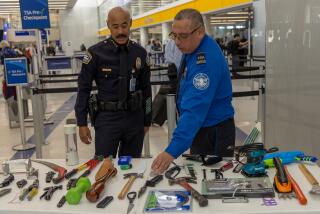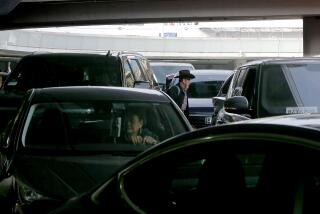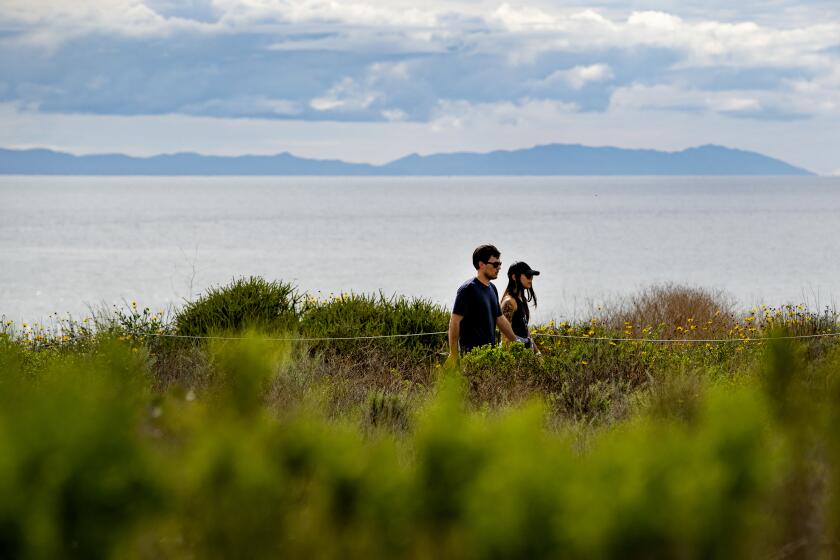Next Deadline on Air Safety Daunting
Closer inspection for bombs hidden in baggage--the first step in building a new aviation security system--begins across the nation today, but the next big deadline facing the government is even more daunting.
By the end of the year, 429 airports with regularly scheduled airline service must install machines to detect explosives that would make baggage screening much more secure than the temporary measures announced this week. Yet even if enough of the $1-million machines can be built in time--about 2,200 are needed--Los Angeles International and many other airports simply lack the space for the truck-sized units. It is one of many problems confronting aviation officials for which there are still no answers.
“I think by mid-summer they’re going to realize they can’t meet the deadline--they’re going to have to modify it,” said Michael DiGirolamo, deputy director of operations at LAX. “This is the most overwhelming project that the industry has faced, both on the government side and the airlines’ side. I think it’s so large and so overwhelming that I don’t think people have grasped just how large and overwhelming it is.”
Publicly, Transportation Department officials say they will do “everything humanly possible” to meet the Dec. 31 deadline set by Congress. But privately, some officials concede that the odds are against them.
The logistical problems quickly became apparent at LAX. Airport managers were flabbergasted when their calculations showed they might need as many as 251 of the 3-ton machines to detect explosives because of the sheer volume of baggage the airport handles.
The physical limitations of airports are not the only challenges for the fledgling Transportation Security Administration.
As the year unfolds, the agency also will be taking over passenger screening by deploying a yet-to-be-hired force of nearly 30,000 uniformed federal employees. Much of the changeover will take place during the summer travel season.
In addition, airlines are pushing for a government-approved “trusted traveler” program that would grant several million people who agree to periodic background checks special credentials allowing them to use high-speed checkpoints.
“We have to build a new law enforcement agency starting essentially from scratch--an agency with more people than the FBI, the Drug Enforcement Administration and the Border Patrol combined--and get it up and running in the next 11 months,” Transportation Secretary Norman Y. Mineta said.
Explosives detection remains the greatest challenge, Mineta said.
A journey through the bowels of LAX’s baggage-handling system reveals the problem: The miles of screeching conveyor belts were never designed to incorporate bomb-screening in the first place.
At the Bradley terminal, an 18-year-old conveyor belt shudders as it ferries hundreds of bags from ticket counters to the quarter-mile-long sorting room. The system backs up quickly. Bags linger on the floor, waiting to be loaded into metal luggage containers. At one conveyor, workers place bags through a decades-old X-ray machine mounted in the back of a beat-up van.
Just one month ago, LAX officials said they would need 120 of the new machines to detect explosives, which employ CT technology similar to what hospitals use to find tumors in the human body. But after receiving additional data from the Federal Aviation Administration, officials more than doubled that estimate, to 251. It turns out that LAX--the world’s third-busiest airport--handles a disproportionately large share of “originating” bags, those that are first entering the system.
“We’re the worst-case scenario, because more bags are checked here than at any other airport in the world,” LAX spokesman Paul Haney said.
At some other major airports, like Chicago’s O’Hare, a bigger proportion of the passengers are connecting and have already checked their bags. Under the system due to be in place by year’s end, those bags would have been scanned at the originating airport.
While the scale of problems may not be as overwhelming as at LAX, other airports are going to encounter the same space crunch, said Paul Bollinger, a vice president of HNTB, an architectural and engineering firm that specializes in airports.
“We are looking at going back to retrofit airports to incorporate this equipment, and the space may not be there,” Bollinger said. “That’s when it’s going to get expensive.”
Indeed, the 13 machines that currently operate at LAX have been installed in passenger check-in areas, because there’s no room for them elsewhere. They are so heavy that engineers will not allow them to be placed in certain locations.
Most airlines at LAX have yet to unveil their plans for the new machines. (The federal government will pay for the equipment, but the airlines and airports must find a place to put it.) American Airlines has discussed closing a gate--worth millions of dollars in ticket revenue--to build an area that would incorporate 18 machines.
Starting Feb. 1, airlines will begin collecting a passenger security fee of $2.50 per leg of a trip, with a limit of $10 on a round-trip ticket. That is expected to raise more than $1.7 billion a year, no more than a down payment on the as-yet-unknown cost of the new security system.
Some experts are warning that the fixation on deadlines and new machines could backfire. Thomas Hartwick, chairman of a National Academy of Sciences panel on aviation security, is concerned that the new security agency will lose sight of the overall picture.
“All the pieces have to play together,” Hartwick said. The system “will only be as strong as its weakest part.”
Over time, the new airport security measures are bound to affect nearly every family in the United States, since airlines transport nearly 700 million passengers a year. Among other possible changes:
* When a customer calls to make a reservation, airlines will make greater use of profiling software to separate passengers who pose no risk from those who might, and therefore deserve a closer look.
* More shops and restaurants will be located before the security screening checkpoints, instead of in concourse areas that are now open only to ticketed passengers. At LAX, about 95% of the concessions are located beyond security, and many are suffering heavy losses.
* Passenger checkpoints may get independent means of validating identification. In addition to standard metal detectors and X-ray machines, there may be computer terminals that allow a quick check of passengers’ driver’s licenses, much like the equipment found in police cruisers.
*
Alonso-Zaldivar reported from Washington and Oldham from Los Angeles.
More to Read
Sign up for The Wild
We’ll help you find the best places to hike, bike and run, as well as the perfect silent spots for meditation and yoga.
You may occasionally receive promotional content from the Los Angeles Times.






